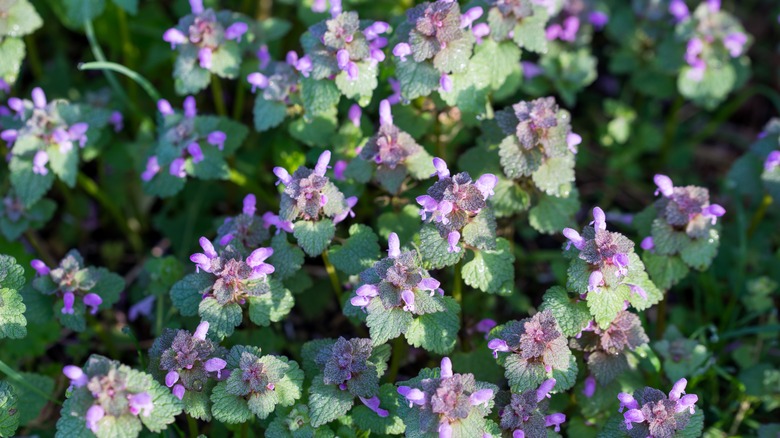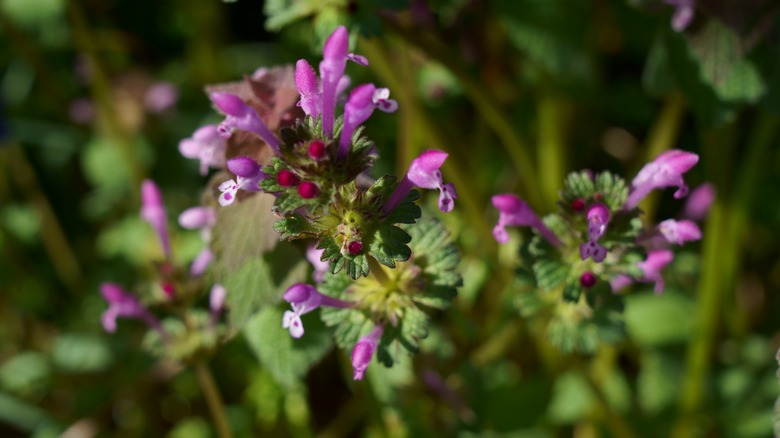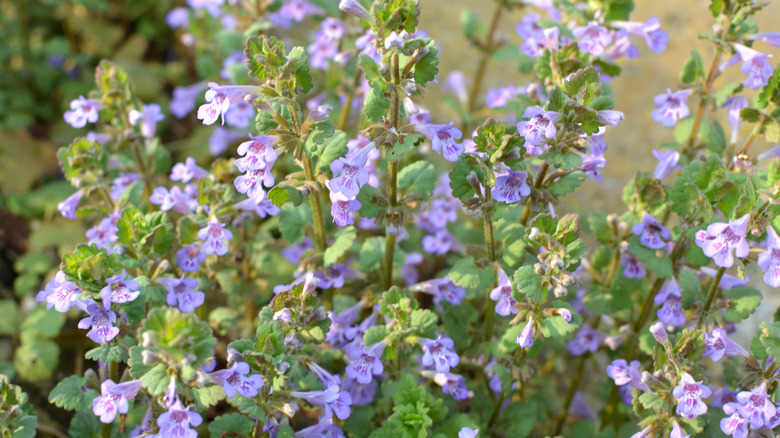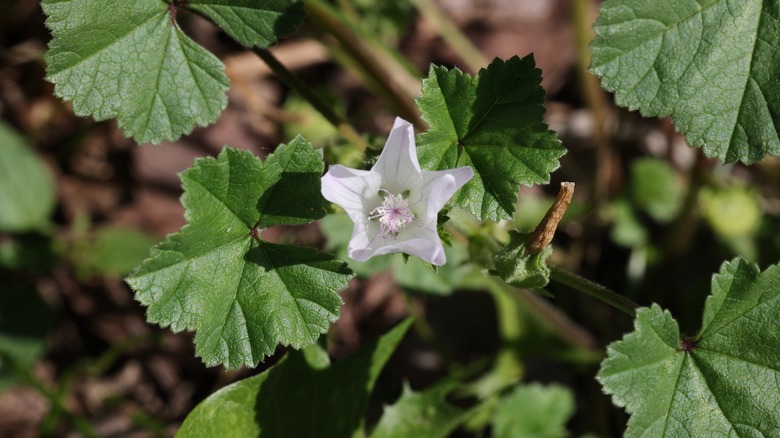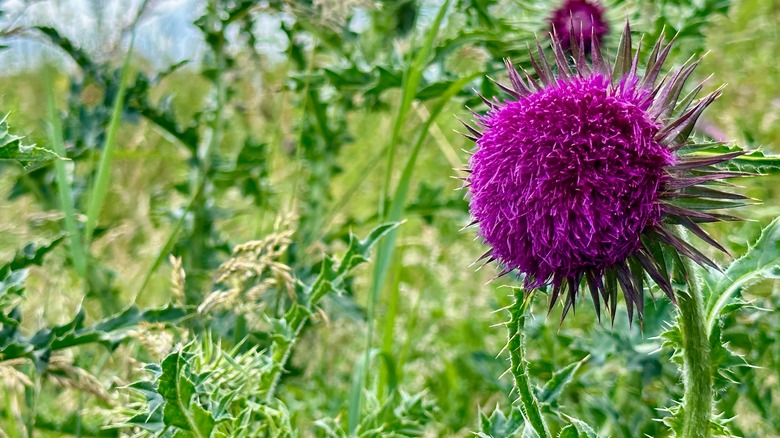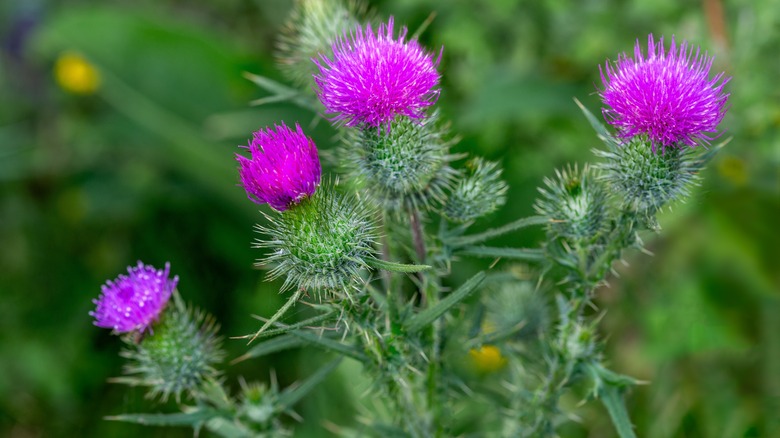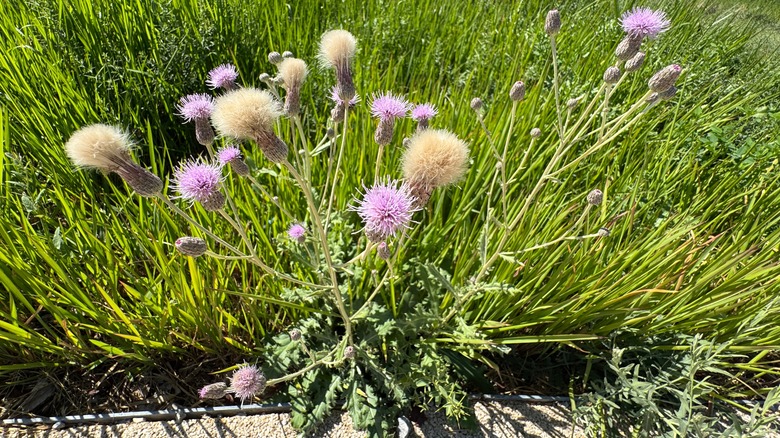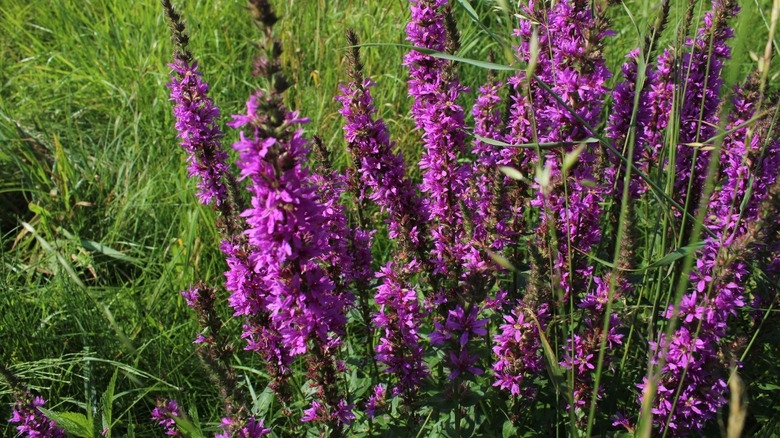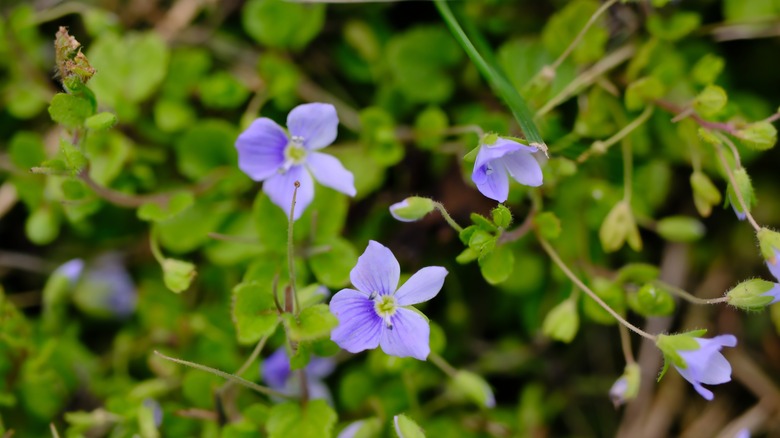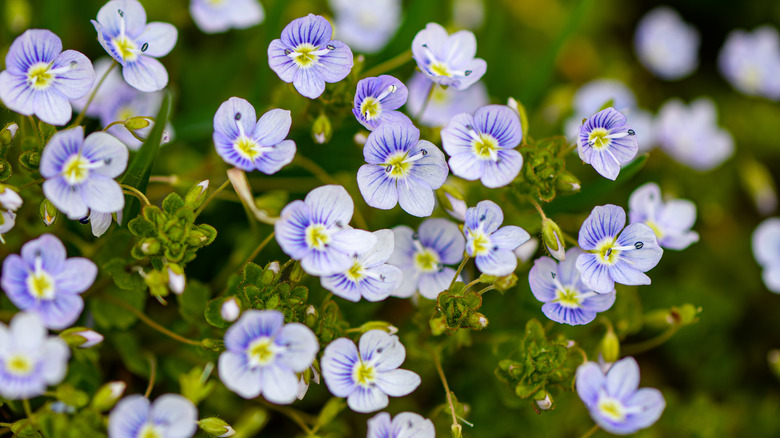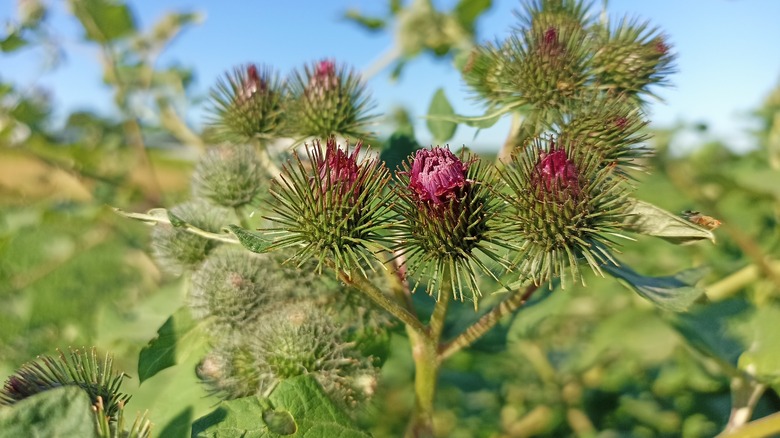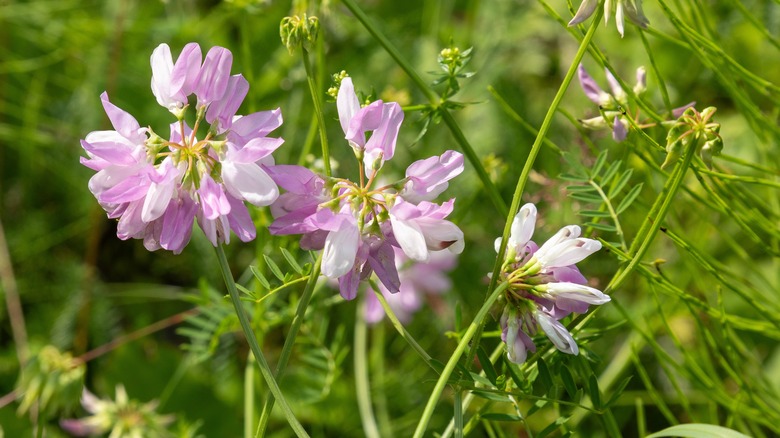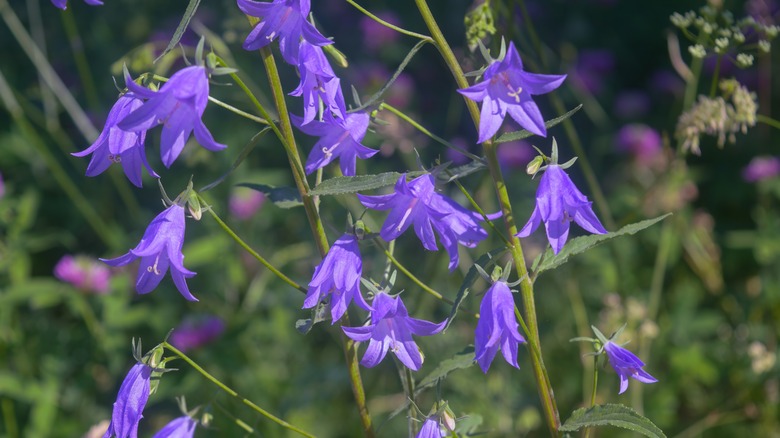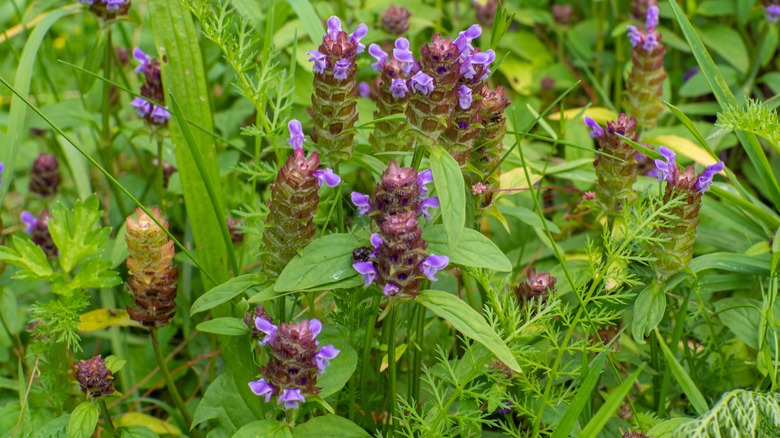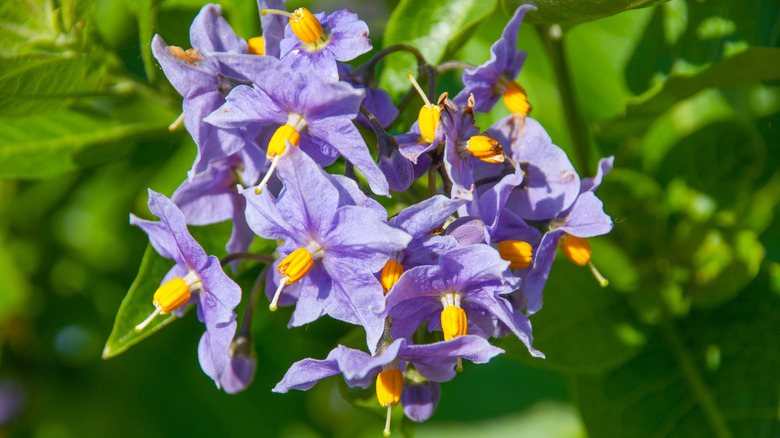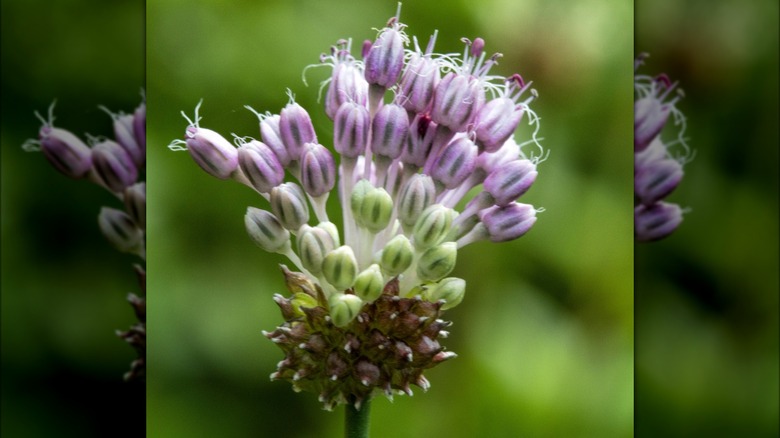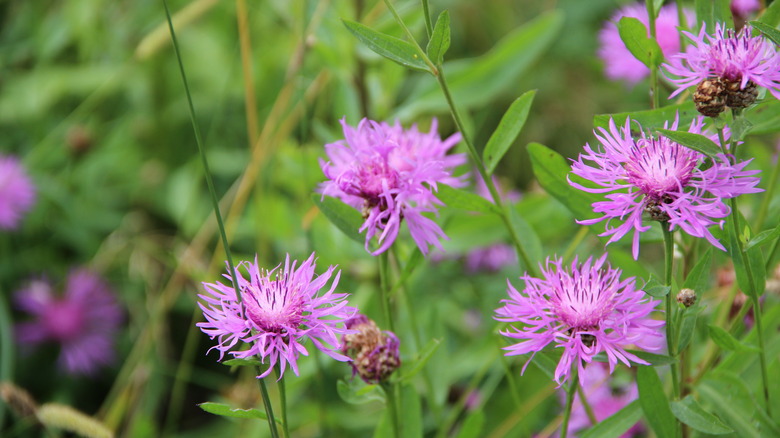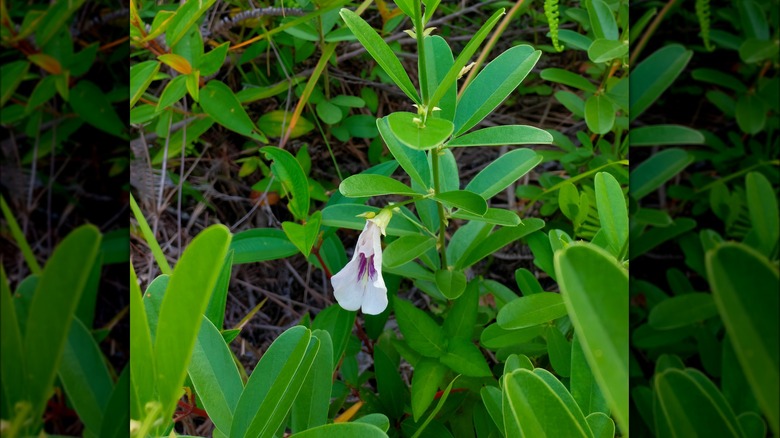Don't Be Fooled By These Pretty Purple Flowers By Learning To Identify Invasive Weeds
Not all invasive weeds announce themselves with rough and tumble or strawy appearances. Sometimes, they come dressed as eye-popping purple blooms that could complement (or even outdo) your prized perennials — if only they weren't aggressive. Purple deadnettle, bull thistle, purple loosestrife, ground ivy, burdock, spotted knapweed, and lespedeza are some such examples. While it's tempting to retain surprise ornamental visitors in your yard, like wild violets, it isn't always a wise call. Invasive plants will suppress desirable shrubbery and turfgrass.
So long as their identity remains a puzzle, they entail the risk of harming your furry friends if they contain toxic chemicals or spines. Worse, they can assume a permanent foothold in your gardens and lawns. After all, just because the frost killed all purple flower invasive weeds doesn't mean it got to their seeds or root fragments, too. Given that, it's pertinent to learn to spot the purple bloomers that aren't merely playing a harmless, decorative role but are out to harm your landscape. Below, we highlight some of these purple-flowering invasive thugs.
Purple deadnettle
Purple deadnettle (Lamium purpureum) plants are sneaky weeds that'll wreak havoc on your lawn during winter. After germinating in the fall, they develop a rosette of purple-tinted, heart-shaped leaves with toothed margins, supporting pale green, hairy undersides. Some top leaves have short petioles. During spring, they bloom two-lipped, purple flowers that fade to release seeds in early summer. They're common in disturbed garden soils or mulched tree beds and have escaped into natural areas across the U.S. Luckily, they don't root deeper than 1 to 2 ½ inches, affording manual pull-out or tilling as effective measures to prevent seed production.
Henbit
Another winter annual weed often confused for purple deadnettle and found growing (sometimes) in its vicinity is henbit (Lamium amplexicaule). While both the weeds have square stems, henbit's blades are relatively smaller, more rounded, and densely fuzzy. Moreover, they've no petioles nor a heavy minty smell. Their purple flowers have dark mottled spots and support longer tubes (which is why they attract hummingbirds and long-tongued bees in early spring). Bare, shadowed patches with moist soils encourage their invasion into lawns. So, keep your turf healthy. Henbits can be safely hoed or pulled out before they've set seed.
Ground ivy
Ground ivy or creeping Charlie (Glechoma hederacea) has become the scourge of lawns across the U.S., except New Mexico, Arizona, and Nevada. In line with its mint cousins, it springs heart-shaped leaves with scallop-like edges. It blooms lavender-to-blue, tubular-shaped flowers from March to July. If not deadheaded, they make way for tan seeds, accelerating their colonization. In moist, poorly-draining, shaded, or compacted soils, it liberally sends out stolons, establishing 3-foot-thick mats and suppressing the surrounding vegetation. This is also why it's so hard to control without using glyphosate, as a tiny fragment can resprout a new plant.
Common mallow
Poorly maintained garden beds and lawns often fall prey to common mallow (Malva neglecta). It's a low grower, staying under 1 foot, with foliage uncannily similar to ground ivy. Though its kidney-shaped, wrinkled leaves are arranged alternately (not opposite) and attached to petioles twice their size. They also lack the distinctive minty aroma common to ivy. Short, coarse hairs may be present on the leaves' base, apex, and stems. From May through October, you'll find five-petalled, papery white to pale purple notched flowers floating above the grass. They spread via seeds and stray plant parts.
Musk thistle
Since musk thistle (Carduus nutans) can produce over 20,000 straw-colored seeds singularly, it quickly carpets the area, outcompeting native vegetation. Due to this, many states, like Minnesota, demand its presence be reported. It's a biennial plant with first-year foliage appearing as lance-like, spiny, footlong rosettes. When it turns two, its upper green blades develop terminal spines, white margins, and pallid green or silver midribs. 3-inch wide, red-to-violet, disk-shaped flowers appear from May to August, nodding to the ground as they mature. Multiple mowing rounds before the thistles bud out can keep them in check.
Bull thistle
Bull thistle (Cirsium vulgare) is another biennial (sometimes annual) invasive weed you should be wary of since it's prevalent across all U.S. states. Its giveaways include the 2-inch wide, gumdrop-resembling purple flowerheads, standing atop spiny green bracts (modified leaves) and blooming from June through September. Its leaves are highly fissured and hairy, terminating in stiff, fierce spines. However, in their birth year, bull thistles only show off a singular, 3-foot-wide rosette while they focus on growing their 28-inch-deep taproot. As they don't reproduce vegetatively, mowing down the 7-foot-tall plants before they've set seeds ensures control.
Canada thistle
Unlike other thistle plants that establish deep taproots, the Canada thistle (Cirsium arvense) relies on a dense network of lateral roots. Moreover, its lavender-to-white, umbrella-clustered flowerheads are relatively smaller, persisting through October. While the foliage is lance-shaped and spiny, it's given to bunching due to the focus on vegetative reproduction. In other words, Canada thistles usually appear as thick strands, topping out at 4 feet. They're mostly concentrated on moist, loamy soils but will establish on dry, sandy sites, provided they're sun-exposed. Banishing thistle weeds from your yard requires combining numerous mowing sessions, pre-flowering, and foliar herbicide applications.
Purple loosestrife
Mostly found in wet soils, purple loosestrife (Lythrum salicaria) is a vibrant purple flowering plant that's actually a noxious weed. It has a history of destroying native vegetation and wildlife habitat, so it's illegal to purchase, sell, or possess this plant in several states. You can recognize it from its 1-foot-long flower spikes ensconced by yellow-throated, pinkish-purple petals between July and September. When not flowering, it leaves out 4-inch long, sword-like, whorled blades. Its taproot produces over 30 stems at a time, encouraging matting growth. Seeds are a problem that can be handled only by digging out the plants before their flowers fade.
Creeping speedwell
Although creeping or slender speedwell (Veronica filiformis) plants make the rounds of nurseries as ornamental groundcovers, they have a penchant for fleeing into lawns. They're considered invasive in West Virginia. They produce violet, four-petaled blooms in early spring atop broad, toothed foliage. Creeping speedwells are hairy all over, including their seed capsules. They establish dense carpets by shooting out rhizomes. Unfortunately, they're difficult to eliminate, as they require the same growth conditions as any healthy turf. Mowing the grass at a raised height to overshadow speedwell might help, though herbicide treatments are usually the only way forward.
Germander speedwell
Another invasive speedwell variety that troubles lawns and home gardens is Germander speedwell (Veronica chamaedrys). They're especially fond of shaded sites containing dry, sandy soils. They produce clusters of tiny violet flowers, though sometimes they may be white or blue. They can be mistaken for creeping speedwell, save for the relatively larger and extended leaves and the upright habit. Moreover, their leaves are arranged at 90 degrees to each other and terminate in rounded teeth vis-à-vis pointed edges for other speedwell weeds. Their fibrous root structure enables their lateral sprawl and return as any split part regrows into new plants.
Great burdock
Hailing from Eurasia, great burdock (Arctium lappa) is a stunning, biennial wildflower that regrettably moonlights as an invasive weed in the U.S. That's because its seeds remain viable for years and spread beyond their confines. First-year growth is easily missed, as it's all about producing a leafy rosette. Things come to a head in the second year when it pushes out large, elephant-ear-esque leaves. These accompany globular, purple flowers from summer through fall. If left unchecked, the flowers wither into spiny burrs that stick to everything, including bird feathers. Digging out the taproot or mowing pre-flowering should stem their spread.
Purple crown-vetch
Traditionally, purple crown-vetch (Securigera varia) has enjoyed the reputation of an ornamental ground cover that checks soil erosion. Unfortunately, it tends to seed profusely, sprout 10-foot-long rhizomes, and escape into natural areas, displacing the existing growth. Since then, it's been classified as an invasive weed in several states, including Kentucky, Virginia, and Georgia. To ID this weed, look for clusters of purplish-pink flowers in the summer (between May and August) — combined, they look very similar to a full-sized clover flower. Its dark green foliage packs into 3-foot-tall thickets. Consistent mowing before they seed aids in management.
Creeping bellflower
Creeping bellflower (Campanula rapunculoides) wouldn't have become the bane it is today were it not for its resemblance to ladybells (Adenophora liliifolia). While both produce purple-to-blue, urn-shaped flowers (usually from June to August), creeping bellflowers are invasive but mis-sold at nurseries as non-invasive ladybells. They produce 3-inch long, triangular-shaped basal blades while the main foliage is slender, like willow trees' leaves. Unfortunately, their leafy characteristics closely match the native violet plants, so it's best to wait for bellflowers to explode in blooms before resorting to eradication. They colonize via their rhizomes, though prodding out their tubers promises control.
Healall
Labeled invasive in West Virginia, common selfheal or healall (Prunella vulgaris) is a creeping lawn weed that outmaneuvers turfgrasses growing on shaded sites. It also takes over heavily fertilized, moist areas. Healall sprouts distinctive, puckered ovate leaves coated in tiny, white hairs. Their blades are generally arranged at right angles, giving off a square appearance, and are purple-mottled at their bases. Healall weeds max out at 1 foot, which is why their presence becomes noticeable only after they become festooned in pineapple-esque, purple flowers during the summer. Since mowing cannot shear them off, they must be removed manually.
Bittersweet nightshade
Bittersweet nightshade (Solanum dulcamara) is a nearly 10-foot tall woody vine that often winds up in backyards with moist, disturbed soils. You may also find it wrapped around alder and willow trees. Tell-tale signs include clouds of tubular lavender flowers between May and September. These are shortly followed by green fruits that ripen into red berries during the fall, spreading aggressively. That's because the birds disseminate their yellow seeds. Bittersweet has nearly 2 ½ inch-wide leaves that release a horrid stench when crushed. They also send across suckers, establishing wherever they touch the soil.
Field garlic
Field garlic (Allium vineale) is an invasive weed common to woodland gardens and lawns in the eastern U.S. region. But since its spring growth merely transpires as slender, chive-like leaves that merge with the grass, its presence goes unnoticed unless you run it over with a lawn mower and whiff its pungent odor. It develops 3-inch-wide lavender inflorescences late into the growth season that split open to reveal star-shaped flowers. Digging the plant out from damp soil before it produces its bulb offsets should thwart its spread. Regular mowing helps reduce its food reserves and seeding.
Spotted knapweed
Spotted knapweed (Centaurea maculosa) has a penchant for settling in sandy, dry, or infertile soils. Its bushy mound stands over 2 feet tall, supported by gray or blue-tinged, dissected green blades that grow progressively less lobed toward their tip. Between July and September, it puts on a rogue show of thistle-shaped purple flowers that bob over black-mottled bracts — hence the name. It's considered invasive and noxious across most U.S. states, including California and Connecticut. Spotted knapweeds are profuse seeders and must be diligently mowed while the flower stalks are in their early development phase.
Common lespedeza
If your lawn is under-fertilized, under-watered, or features bare patches, it may invite common lespedeza (Kummerowia striata) or Japanese clover. Lespedeza is a summer annual weed that establishes itself as a 15-inch-thick patch, particularly in the east U.S. However, some knowingly grow it for its nitrogen-fixing benefits, despite its history of escaping cultivation. Each white-haired, purple stem is ladled with compound, trifoliate leaves extending 1 inch long and half as wide. Around mid-summer, it's decked in pea-shaped, four-petaled, pinkish-purple flowers. Seed-holding fruits may follow unless mowing height isn't raised to outcompete them.

